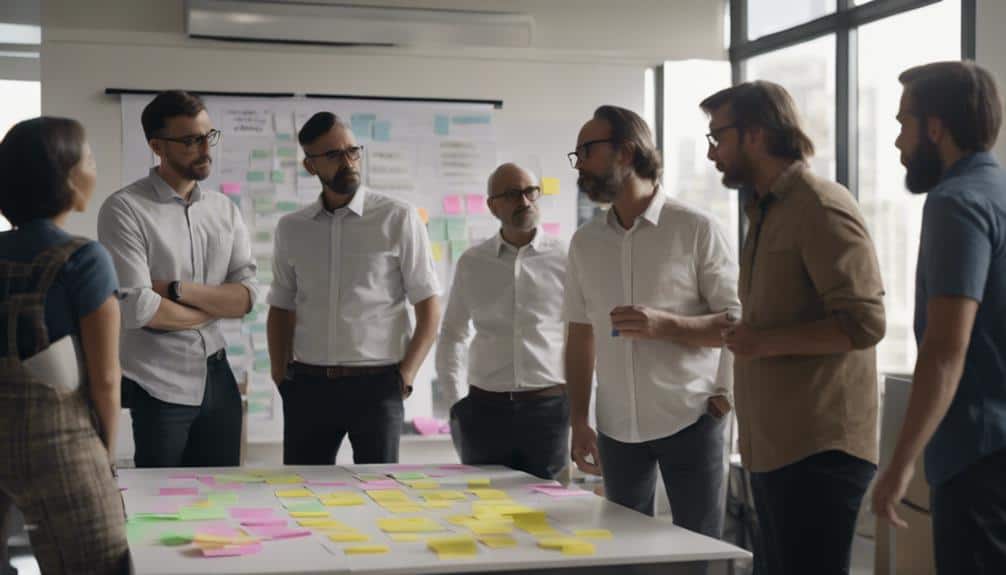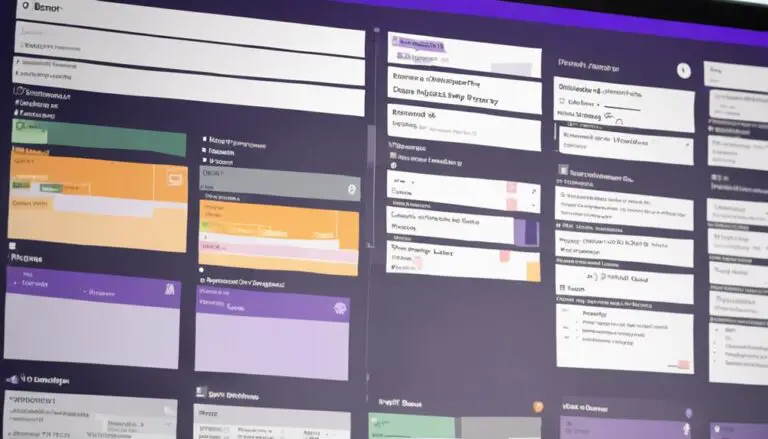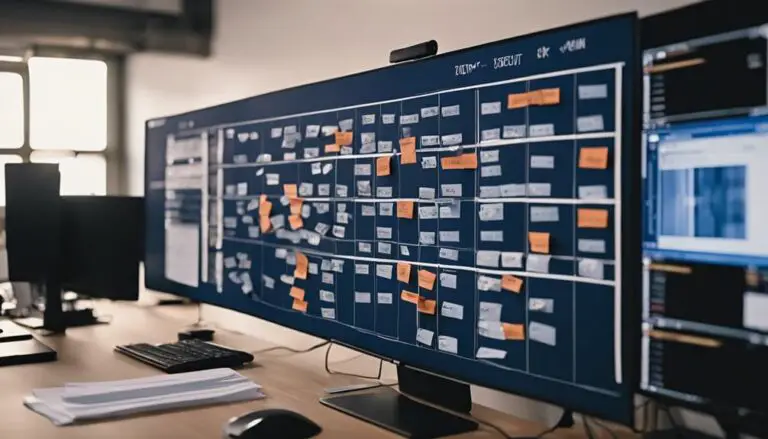You might be wondering how Kanban, known for its focus on workflow visualization and limiting work in progress, can effectively incorporate retrospective practices. Kanban’s focus on continuous improvement makes it an ideal framework for incorporating retrospective practices. By regularly reflecting on past work and identifying areas for improvement, teams using Kanban can make meaningful adjustments to their processes. Through kanban change implementation, teams can easily experiment with different improvements and track the impact of those changes on their workflow. This iterative approach to improvement aligns perfectly with the principles of Kanban, making retrospective practices a natural fit for teams utilizing this framework.
However, as you explore the step-by-step guide, you'll uncover actionable strategies to maximize the benefits of retrospective meetings within the Kanban framework.
By understanding the intricate connection between Kanban principles and retrospective reflections, you'll gain valuable insights into enhancing team dynamics and driving continuous improvement.
Key Takeaways
- Establish clear goals and expectations for a productive retrospective session.
- Analyze metrics and feedback to pinpoint areas for improvement collaboratively.
- Implement small, incremental changes to enhance workflow efficiency.
- Evaluate the impact of changes on productivity and make informed decisions for continuous improvement.
Understanding Kanban Retrospectives
When embarking on a Kanban journey, understanding Kanban retrospectives is crucial for fostering team reflection and continuous improvement. In Kanban implementations, retrospectives play a vital role in enhancing client satisfaction, improving team-stakeholder relationships, and nurturing team culture. By focusing on analyzing cycle time, throughput, and work in progress, these sessions enable teams to identify areas for enhancement and implement solutions effectively. Kanban retrospectives align with the principles of the Agile Manifesto, emphasizing the importance of individuals and interactions, customer collaboration, responding to change, and continuous improvement.
Through these structured meetings, teams can promote continuous learning, enhance collaboration and communication, increase transparency, and support adaptability to change. Different types of retrospectives cater to various workflow dynamics and team requirements, ensuring that the retrospective process is tailored to the specific needs of the team. By engaging in regular retrospectives and service delivery reviews, teams can iterate on their processes and continuously strive for improvement, ultimately enhancing their overall performance and service delivery.
Setting the Stage
To set the stage effectively for a Kanban retrospective meeting, focus on creating an environment conducive to open communication and feedback. This initial step is crucial in laying the foundation for a successful reflection on the team's Agile processes and continuous improvement. Here are some key actions to consider:
- Establish Clear Goals: Clearly define the purpose of the retrospective and what the team aims to achieve during the session.
- Set Expectations: Communicate the importance of active participation from all team members and encourage honest and constructive feedback.
- Create a Safe Space: Ensure that team members feel comfortable sharing their thoughts and concerns without fear of judgment.
- Encourage Collaboration: Emphasize the collective effort needed to identify areas for improvement and work towards common goals.
- Highlight the Value of Reflection: Remind the team of the significance of reflecting on past work to drive future success.
Identifying Improvement Areas
In the process of identifying improvement areas during a Kanban retrospective, focus on analyzing workflow data and metrics to pinpoint bottlenecks and inefficiencies. By examining cycle time, throughput, and work in progress (WIP) data, you can uncover patterns and trends that highlight areas for enhancement in the Kanban process.
Look for delays in delivery, bottlenecks that slow down progress, and any inefficiencies that hinder workflow efficiency. Additionally, discussing team feedback, observations, and challenges plays a crucial role in identifying improvement opportunities.
Prioritize these areas based on their impact, feasibility, and alignment with team goals to ensure effective retrospective action planning. Remember, the goal is to collaboratively work towards optimizing the Kanban process for smoother workflows and improved team productivity.
Stay engaged in this process to collectively drive positive changes that benefit the entire team and enhance project outcomes.
Implementing Changes
To enhance your Kanban process effectively, implementing changes involves strategically prioritizing actionable items that address workflow inefficiencies and foster improved collaboration within your team.
When it comes to implementing changes based on Kanban retrospectives, consider the following steps:
- Prioritizing Actionable Items: Focus on actionable items that have been identified as key areas for improvement during retrospectives.
- Addressing Workflow Inefficiencies: Target bottlenecks and inefficiencies in your workflow to streamline processes and enhance productivity.
- Improving Collaboration: Look for opportunities to enhance team collaboration and communication to boost overall efficiency.
- Experimenting with Small Changes: Implement small, incremental changes to avoid disrupting the workflow drastically.
- Measuring Impact: Regularly measure the impact of the implemented changes to assess their effectiveness and make adjustments as necessary.
Evaluating Impact
Analyzing the effects of implemented changes on team performance and workflow is crucial in evaluating the impact within Kanban retrospectives.
As you reflect on the outcomes of your retrospective actions, consider using metrics like cycle time reduction, increased throughput, and decreased lead time to measure the impact on your team's productivity and efficiency.
By assessing the data presented on your Kanban Board and Cumulative Flow Diagram, you can gain insights into how the changes have influenced your workflow. Impact evaluation not only helps you understand the effectiveness of your retrospective meetings but also guides you in making informed decisions for continuous improvement.
Reflecting on the impact of retrospective decisions is key to fostering growth within your team.
This process enables you to determine whether the implemented changes have led to the desired improvements or if further adjustments are necessary.
Continuous Improvement Practices
Let's focus on how continuous improvement practices in Kanban retrospectives drive iterative process enhancements and foster team collaboration enhancements.
By analyzing workflow metrics and addressing blockages, teams can identify areas for growth and implement effective solutions.
Emphasizing learning and accountability, these practices aim to cultivate a culture of reflection and continuous growth within the team.
Iterative Process Enhancements
Enhancing your iterative process in Kanban retrospectives involves implementing continuous improvement practices to refine and optimize workflow efficiency. To enhance your iterative process effectively, consider the following:
- Analyze past iterations to identify bottlenecks and inefficiencies.
- Implement incremental changes based on retrospective findings.
- Foster a culture of continuous learning and adaptation.
- Focus on data-driven insights, collaborative problem-solving, and feedback loops.
- Optimize performance, increase productivity, and deliver higher quality outcomes through iterative review and process adjustments.
Team Collaboration Enhancements
To foster a culture of continuous improvement within your team during Kanban retrospectives, prioritize open communication and active knowledge-sharing to enhance collaboration and boost team engagement.
Team collaboration enhancements in Kanban retrospectives focus on continuous improvement practices by encouraging the sharing of knowledge and engaging team members in problem-solving. By involving everyone in active participation, innovative solutions can arise, leading to optimized workflow processes.
Embracing continuous improvement involves identifying areas for enhancement, creating action plans, and monitoring progress over time. Leveraging team collaboration in retrospectives enables Kanban teams to drive incremental changes effectively.
Frequently Asked Questions
How Do You Conduct a Kanban Retrospective?
To conduct a Kanban retrospective, gather the team for valuable feedback, analyze data for insights, brainstorm improvement ideas collaboratively, plan actions for continuous improvement, optimize processes together, and facilitate the retrospective effectively to foster team collaboration and growth.
Does Kanban Have a Retro?
Yes, Kanban has retrospectives. They offer benefits like team feedback, continuous improvement, and fostering a learning culture. Retro process aligns with agile methodology and Kaizen principles, emphasizing reflection techniques for enhancing team performance.
How Often Do You Run Retrospectives in Kanban?
In Kanban, you run retrospectives at a frequency that suits your team – weekly, bi-weekly, or monthly. By scheduling these regular check-ins, you ensure consistent reflections and ongoing improvements to your process.
What Are the Steps in Kanban?
To improve your workflow in Kanban, start by visualizing it for better understanding. Collaborate with your team, analyze cycle times, identify bottlenecks, brainstorm solutions, and track progress. Continuous improvement through problem-solving techniques enhances process efficiency.
Conclusion
So, now you have the tools to rock your Kanban retrospective meetings!
Remember, continuous improvement is like a fine wine – it gets better with time.
Keep collaborating, identifying areas for growth, implementing changes, and evaluating impact.
Cheers to a more efficient and effective team dynamic!





